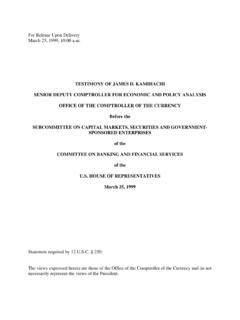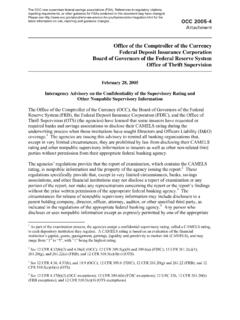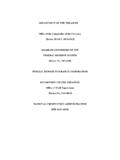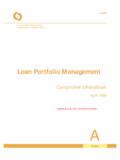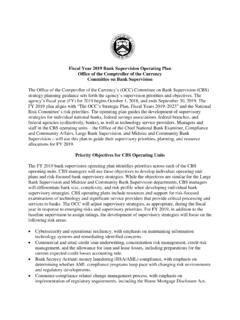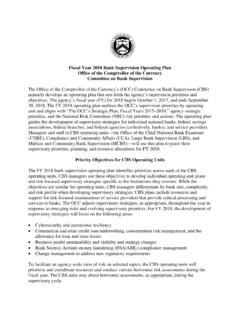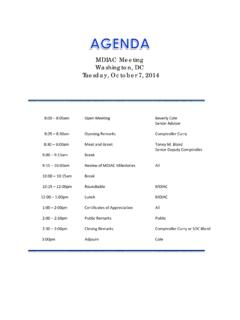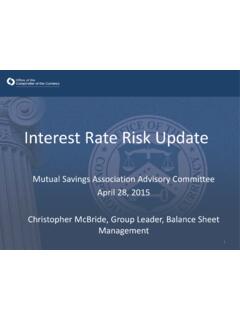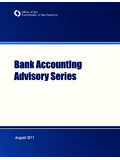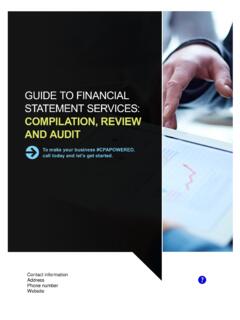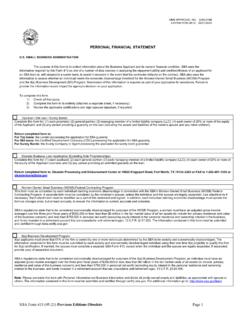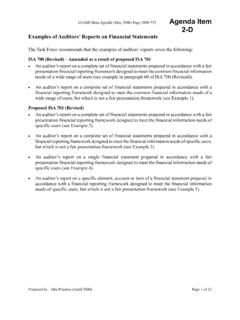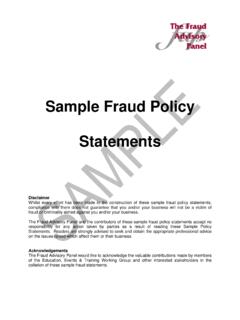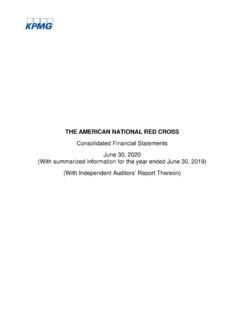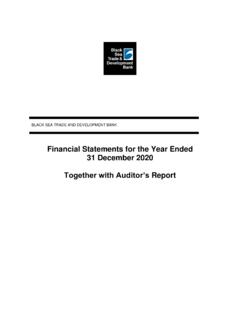Transcription of This booklet was prepared by the Check Fraud Working …
1 This booklet was prepared by the Check Fraud Working Group, a subgroup of the interagency Bank Fraud Working Group. That Working group includes representatives from the Federal Bureau of Investigation, the Department of Justice, Federal Deposit Insurance Corporation, Federal Reserve Board, Internal Revenue Service, Office of the Comptroller of the Currency, Office of Thrift Supervision, Postal Inspection Service, National Credit Union Administration, and Secret Service. The Check Fraud Working Group was convened to provide a forum to explore ways to combat Check Fraud perpetrated against insured deposito- ry institutions. Check Fraud : A Guide to Avoiding Losses February 1999. 1. Background schemes and presents tactics for use in combating Check Fraud . It cannot describe comprehensively all types of Check Fraud or C. Check Fraud schemes, because the variations are limitless.
2 Heck Fraud is one of the largest challenges facing financial Although this booklet is a general guide, financial institutions institutions. Technology has made it increasingly easy for should look to state and local laws for other guidance. It can, criminals, either independently or in organized gangs, to however, get bankers, tellers, operations personnel, and security create increasingly realistic counterfeit and fictitious checks as officers to think about the problem and show how they can help well as false identification that can be used to defraud financial protect their institutions from Check Fraud . institutions. The scope of the problem can be shown by some recent statis- Significant Terms tics. According to the Department of the Treasury, financial Crimes Enforcement Network's (FinCEN) 18 Month Some technical terms relating to checks and drafts2 are worth Analysis of the Suspicious Activity Reporting System (SARS), defining.
3 43 percent1 of SARs reported for criminal referral between April 1996 and September 1997 related to Check Fraud , counter- Customer a person with an account at the financial institution. feit checks, and Check kiting. financial institutions lost an esti- mated $1 billion to those Check Fraud related schemes during Drawee a party, typically a financial institution, that is that time. required to pay out the money when a Check or draft is present- ed. The drawee is usually the payer financial institution. To protect the banking industry and its customers from Check Fraud , financial institutions must become familiar with common Drawer a person writing a Check . The drawer is typically a Check Fraud schemes. This booklet describes some of those customer of the drawee. 1 This figure does not include Bank Secrecy Act reported violations. 2 In credit unions, these instruments are referred to as share drafts.
4 2. MICR (Magnetic Ink Character Recognition) Check Fraud criminals may be financial institution insiders, numbers at the bottom of a Check , printed in magnetic ink, that independent operators, or organized gangs. The methods they can be read by machines. The numbers usually are encoded use to further Check Fraud include: with the name and address of the drawee financial institution, the account number, and the Check number. The dollar amount Getting customer information from financial institution insid- is added to the MICR line during Check processing. ers. Stealing financial institution statements and checks. Payee a party entitled, by the creation of a draft or Check , to Working with dishonest employees of merchants who accept receive funds from a drawee. payments by Check . Rifling through trash for information about financial institu- Presentment the delivery of a Check or draft to the drawee or tion relationships.
5 The drawer for payment. Descriptions of some common Check Fraud schemes follow, with information on what makes them successful, and Check Fraud Schemes what bankers can to do avoid them. Fraud schemes involving checks take many forms. Checks may Altered Checks be: Altered checks are a common Fraud that occurs after a legitimate Altered, either as to the payee or the amount. maker creates a valid Check to pay a debt. A criminal then takes Counterfeited. the good Check and uses chemicals or other means to erase the Forged, either as to signature or endorsement. amount or the name of the payee, so that new information can Drawn on closed accounts. be entered. The new information can be added by typewriter, in Used in a variety of schemes. handwriting, or with a laser printer or Check imprinter, whichev- er seems most appropriate to the Check . 3. Example 1: compartment of a car.
6 The criminal uses the signatures on the identification in the wallet to forge the endorsement. Then, using A door-to-door salesman sells a set of encyclopedias for $ the identification in the wallet, altered, if necessary, the criminal The customer pays by Check , writing $ to the far right on cashes the Check at the payee's financial institution. the line for the amount in figures, and the words sixty-nine and 99/100 to the far right of the amount in the text line. The crim- Altered Check schemes can be successful when customers are inal uses the blank spaces on both lines to alter the Check careless and financial institutions fail to Check payee identifica- by adding 9 before the numbers line, and the words Nine tion properly. Hundred before the text line. The $ Check is now a Fraud - ulent Check for $ , which the criminal cashes. To protect against such frauds, customers should: Example 2: Avoid leaving large blank spaces in the number or amount lines on checks they write.
7 A small company that provides service to several small clients is Report to drawee or payer financial institutions when their paid by checks payable to Johnson CO. or Johnson checks are stolen. Company. Criminals steal a number of those payment checks and use a chemical solution to erase the word Co. or Company. financial institutions should: They then type in the word Cooper, and subsequently cash the checks using false identification. Review checks to ensure that the handwriting or print styles are consistent, and that no signs of erasure or alteration show. Example 3: Compare the signatures on items and the appearance of the presenter with the signature and picture on the identification. A criminal steals a wallet, with a Check in it, from the glove 4. Counterfeit Checks have access to information and supplies from financial institu- tion insiders. Counterfeit checks are presented based on fraudulent identifica- To protect against such frauds, customers should protect their tion or are false checks drawn on valid accounts.
8 Personal information, including account records. Example 1: financial institutions should: A group of criminals open checking accounts, cash counterfeit Review customer identification thoroughly. checks, and file false tax returns, using fraudulent drivers' Maintain separation of functions, so that no one person has licenses, social security cards, and other identification. They use account information and access to controlled supplies, such information from personal and corporate trash to produce the as commercial Check stock. identification with computer technology. Use mailings and other methods to warn customers about Check Fraud and the need to protect their information. Example 2: A financial institution insider identifies corporate accounts that maintain large balances, steals genuine corporate checks, coun- Identity Assumption terfeits them, and returns the valid checks to the financial insti- tution.
9 The financial institution insider is associated with a Identity assumption in Check Fraud occurs when criminals learn group of criminals that distributed the counterfeit checks information about a financial institution customer, such as name, throughout the area and cashes them using fictitious accounts. address, financial institution account number, social security number, home and work telephone numbers, or employer, and Counterfeit Check schemes can be successful when criminals are use the information to misrepresent themselves as the valid skillful in their use of technology to create false documents or financial institution customer. These schemes may involve changing account information, creating fictitious transactions 5. between unsuspecting parties, or preparing checks drawn on the pares the stolen checks to be payable to the valid account at valid account that are presented using false identification.
10 financial institution A. Using fraudulent identification, one of the criminals poses as the payee to cash the checks at drive- This Fraud is made easier when organizations, such as state through windows at financial institution A. Because the crimi- departments of motor vehicles, use social security numbers on nals know that sufficient cash exists in the account to cover the drivers' licenses as identification. In such states, because those Check , they can ask safely for immediate cash. numbers are more available, financial institutions must be espe- cially careful. Example 3: Example 1: A criminal uses customer information, sometimes from a finan- cial institution insider, to order checks from a Check printer or to A financial institution customer pays a bill in the normal course create counterfeit checks and false identification. The criminal of business. An employee of the payee copies the Check and then writes fraudulent checks and presents them for deposit into provides it to a partner in crime who contacts the financial insti- the customer's account, requesting part of the deposit back in tution and, using information from the Check , pretends to be the cash.
